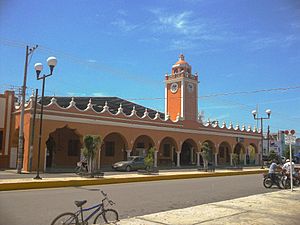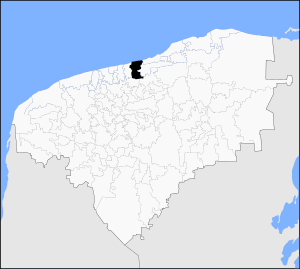Dzidzantún facts for kids
Quick facts for kids
Dzidzantún
|
|
|---|---|
|
Town
|
|

Municipal Palace of Dzidzantún
|
|

Location of the Town in the State of Yucatán
|
|
| Country | |
| State | |
| Area | |
| • Total | 198 km2 (76 sq mi) |
| Elevation | 10 m (30 ft) |
| Population
(2020)
|
|
| • Total | 8,345 |
| • Density | 42.15/km2 (109.16/sq mi) |
| • Demonym | Dzidzantunence |
| town | |
| Time zone | UTC-6 (Central Standard Time) |
| • Summer (DST) | UTC-5 (Central Daylight Time) |
| Area code(s) | 991 |
| INEGI Code | 027 |
| Major Airport | Merida (Manuel Crescencio Rejón) International Airport |
| IATA Code | MID |
| ICAO Code | MMMD |
| Website | Official Website: http://www.dzidzantun.gob.mx |
Dzidzantún is a lively town in the northeastern part of Yucatán, Mexico. It's the main town for the Dzidzantún Municipality, which is like a county or administrative area. This means Dzidzantún is the center for local government and services for the surrounding area.
Contents
Exploring Dzidzantún's Location
Dzidzantún is located right by the coast, close to the Gulf of Mexico. Imagine drawing lines on a map: the town sits between 21°12' and 21°23' north latitude and 88°57' and 89°04' west longitude. It's pretty close to sea level, only about 4 meters (or 13 feet) high on average.
Neighboring Towns and Borders
The town has some interesting neighbors! To the north, it touches the big Gulf of Mexico. To the south, you'll find the towns of Temax and Cansahcab. On its eastern side is Dzilam Gonzalez, and to the west is Yobaín.
Dzidzantún's Climate
Dzidzantún has a warm climate throughout the year. You can see more details about the temperatures and rainfall in the table below.
| Climate data for Dzidzantún | |||||||||||||
|---|---|---|---|---|---|---|---|---|---|---|---|---|---|
| Month | Jan | Feb | Mar | Apr | May | Jun | Jul | Aug | Sep | Oct | Nov | Dec | Year |
| Mean daily maximum °C (°F) | 32.4 (90.3) |
33.7 (92.7) |
34.7 (94.5) |
35.3 (95.5) |
36.2 (97.2) |
35.8 (96.4) |
35.8 (96.4) |
35.9 (96.6) |
35.6 (96.1) |
34.8 (94.6) |
33.2 (91.8) |
32.7 (90.9) |
34.7 (94.5) |
| Mean daily minimum °C (°F) | 18.5 (65.3) |
19.5 (67.1) |
20.2 (68.4) |
20.6 (69.1) |
21.5 (70.7) |
21.8 (71.2) |
21.9 (71.4) |
22.1 (71.8) |
21.9 (71.4) |
21.3 (70.3) |
19.9 (67.8) |
18.8 (65.8) |
20.7 (69.3) |
| Average precipitation mm (inches) | 30 (1.2) |
30 (1.2) |
25 (1) |
18 (0.7) |
53 (2.1) |
110 (4.3) |
100 (4) |
110 (4.3) |
130 (5.2) |
110 (4.2) |
41 (1.6) |
43 (1.7) |
800 (31.6) |
| Source: Weatherbase | |||||||||||||
Who Lives in Dzidzantún?
In 2020, about 8,345 people called Dzidzantún home. It's almost an even split between boys and girls! About half the population is male (4,211 people) and the other half is female (4,134 people).
Age Groups and Languages
Many young people live here, with the largest groups being 15 to 19-year-olds, 45 to 49-year-olds, and 20 to 24-year-olds. It's cool to know that some people in Dzidzantún also speak indigenous languages. About 416 residents speak a native language, and most of them speak Maya.
A Look Back at Dzidzantún's History
Long, long ago, even before the Spanish arrived, the land where Dzidzantún now stands was part of an important area ruled by a leader called Ah Kin Chel.
Spanish Arrival and Early Days
When the Spanish took control, they set up a system called an encomienda in 1549. This meant a Spanish person, Hernán Muñoz Vaquiano, was given the right to use the land. In return, he was supposed to take care of the local people living there.
Becoming Part of Mexico
Yucatán became independent from Spain in 1821. A few years later, in 1825, Dzidzantún became part of the Temax Municipality. But then, in 1918, Dzidzantún got its own municipality, making the town the main center for its own local government.
Fun Festivals and Local Culture
Dzidzantún is a place that loves to celebrate! There are several special festivals throughout the year.
Popular Festivals
- January: People celebrate in honor of Santa Clara.
- June 10–13: A big festival honors San Antonio de Padua, who is the town's special patron saint.
- August 8–14: Another festival for Santa Clara, with her main day on August 11.
Traditional Clothing Styles
When there are festivals, you'll see people wearing beautiful traditional clothes:
- For Women: They often wear a simple Huipil. This is a special dress with a square neck that has pretty embroidery. It's worn over a long skirt that's gathered at the waist. They also wear comfortable sandals and a shawl to protect from the sun.
- For Farmers and Elders: Older men, especially farmers, wear loose trousers, simple shirts, and straw hats.
- For Special Events: For bigger parties and dances called Vaquerías, women wear a fancy Terno dress. These dresses are made from fine fabrics and often have beautiful, handmade embroidery. They complete their look with long gold chains, earrings, and a special shawl.
- For Men at Events: Men wear white trousers, fine shirts, and special hats like the Jipijapa. They also wear a traditional red scarf, which is important for the lively Jarana dance.
Images for kids
See also
 In Spanish: Dzidzantún para niños
In Spanish: Dzidzantún para niños






